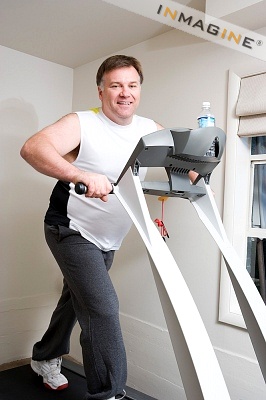 Exercising for 30 minutes daily or an hour every two days are equally effective, findings from a study in 30 men with type 2 diabetes by the researchers from the University of Maastricht in the Netherlands says. Exercising for 30 minutes daily or an hour every two days are equally effective, findings from a study in 30 men with type 2 diabetes by the researchers from the University of Maastricht in the Netherlands says.
 30 type 2 diabetes patients of age 60 years on average and HbA1c 7.2 ± 0.2% were studied and about half were using insulin. Subjects were studied on three occasions for 3 days under strict dietary standardization but otherwise free-living conditions. Blood glucose homeostasis was assessed by continuous glucose monitoring over 48 h during which subjects performed no exercise (control) or 60 min of cycling exercise (50% maximal workload capacity) distributed either as a single session performed every other day or as 30 min of exercise performed daily. 30 type 2 diabetes patients of age 60 years on average and HbA1c 7.2 ± 0.2% were studied and about half were using insulin. Subjects were studied on three occasions for 3 days under strict dietary standardization but otherwise free-living conditions. Blood glucose homeostasis was assessed by continuous glucose monitoring over 48 h during which subjects performed no exercise (control) or 60 min of cycling exercise (50% maximal workload capacity) distributed either as a single session performed every other day or as 30 min of exercise performed daily.
 There were three protocols followed. Under one protocol, the men cycled between 10 and 11 a.m. on the first day, rested from 10 to 11 a.m. the next day, and returned at 10 a.m. on the third day to have the continuous glucose monitoring device removed. Under another protocol, they cycled for 30 minutes starting at 10 a.m. on two consecutive days. In the third phase, they didn't exercise at all. There were three protocols followed. Under one protocol, the men cycled between 10 and 11 a.m. on the first day, rested from 10 to 11 a.m. the next day, and returned at 10 a.m. on the third day to have the continuous glucose monitoring device removed. Under another protocol, they cycled for 30 minutes starting at 10 a.m. on two consecutive days. In the third phase, they didn't exercise at all.
 In the control phase, glucose levels were elevated 32% of the time. But when they had exercised, glucose levels were high only 24% of the time, irrespective of the schedule they followed. The two exercise schedules also did equally well in terms of lowering the mean blood glucose concentration. In the control phase, glucose levels were elevated 32% of the time. But when they had exercised, glucose levels were high only 24% of the time, irrespective of the schedule they followed. The two exercise schedules also did equally well in terms of lowering the mean blood glucose concentration.
 In conclusion, a short 30-min session of moderate-intensity endurance-type exercise substantially reduces the prevalence of hyperglycemia throughout the subsequent day in type 2 diabetic patients. When total work is being matched, daily exercise does not further improve daily glycemia compared with exercise performed every other day. In conclusion, a short 30-min session of moderate-intensity endurance-type exercise substantially reduces the prevalence of hyperglycemia throughout the subsequent day in type 2 diabetic patients. When total work is being matched, daily exercise does not further improve daily glycemia compared with exercise performed every other day.
|

